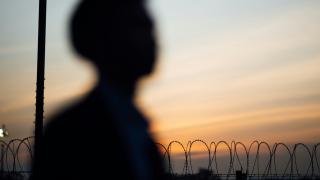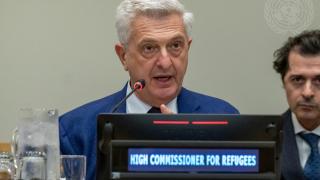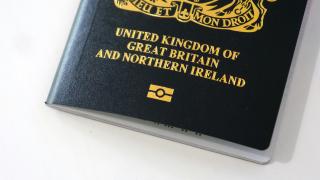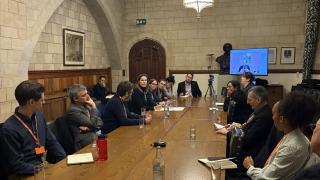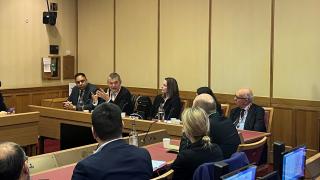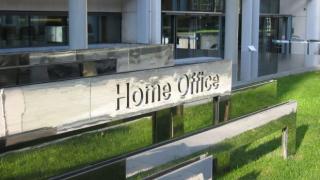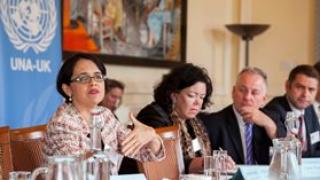
This article by Alexandra Buskie, UNA-UK's Policy & Advocacy Manager, was originally published by the International Coaltion for the Responsibility to Protect (ICRtoP). UNA-UK is a Steering Committee Member of the ICRtoP.
Over the past four years, the United Nations Association – UK (UNA-UK) has been working on a dedicated policy and advocacy programme “to strengthen understanding, support and leadership for the Responsibility to Protect (R2P) principle in the UK’s policy, parliamentary and public arenas”. This has been no small ambition. Engaging the UK Government on R2P and atrocity prevention has represented huge challenges and success has been difficult to measure. What follows is a reflection on these challenges, how we have sought to respond to them and what we have counted as incremental steps towards a stronger national engagement with the principle in practice.
Challenges
First is the challenge of outreach and understanding; R2P is written in the UN’s vocabulary. If you are trying to explain it to someone who does not have the basic level of knowledge of what you mean by 'an international principle', then you are in for a long ride. Learning about R2P means memorising a sea of acronyms, jargon and historical development, when really; the end goal of the principle is pretty obvious: to stop the organised massacre of people before it begins and respond appropriately if you are too late. R2P is also still misunderstood as referring solely to military intervention. No matter how many times R2P advocates say it is not, this is still the prevailing belief. 'Military intervention' provokes more interest than 'capacity building' and people find it simpler to debate. This is a huge obstacle to getting real discussion on how to implement R2P properly, particularly in the public realm, but also in the UK parliament and in some major humanitarian NGOs.
Second is the substantive challenge of getting R2P and atrocity prevention into the national policy vocabulary. Being an R2P advocate in a Western national context can sometimes feel a bit like being a violinist turning up for a brass band rehearsal; you can be good at playing but no one quite understands why you are there. Haven’t we already supported the R2P principle? Isn’t this a UN thing? Aren’t we already doing conflict prevention and stabilisation? Making the argument that the UK should seek to uphold R2P in its national and foreign policies and be a visible leader on this issue has been a slog. The UK’s focus has been on fostering and encouraging international support for the principle amongst UN member states; i.e. keeping up the momentum. There is nothing wrong with that. But at some point, encouraging others isn’t enough. How are you setting an example? Are you walking the talk? Can you share lessons from your experience to help others? This mind-set has been difficult to cultivate for R2P at the national level due to the persistent lack of clear case studies and evidence of what has worked for others.
Third, and building on the last, is the policy challenge of demonstrating R2P’s value added. What proof do you, as an R2P advocate, have that the Government is not doing enough to support the norm? This is not really a challenge unique to R2P but to policy and advocacy more generally. The UK is supportive of R2P at the UN (in both the Security Council and the General Assembly); it has an R2P Focal Point, and the Government is a major funder of the Joint Office of the Special Advisers for Genocide Prevention and R2P, as well as the Global Centre for R2P. What more should it be doing? How should it be doing it? What evidence do you have that it is not doing it, under a different name, like the protection of civilians or preventing sexual violence in conflict? This has been the most significant challenge for UNA-UK in its work on R2P. It’s all fine and well to say the UK should mention R2P and atrocity prevention in its national policy, but what difference does that, or should that, really make to how the Government implements policy?
Response
These challenges have developed over time in the same order as they are described above. As a result, the content of UNA-UK’s programme has shifted, first focusing mostly on outreach and improving knowledge and understanding, then moving to the more substantial policy questions.
We also led small-scale campaigns asking our supporters to sign onto advocacy letters to the Government, requesting information on the work of the R2P Focal Point or on the UK’s approach to protecting the Rohingya in Burma. We led a longer-term campaign on UK foreign policy in the lead up to the elections and encouraged our supporters to input to a public consultation the new Government’s National Security Strategy. All of this included a call to implement R2P at the national level, citing this as a way for the UK to strengthen its global role.Our first response was to try to educate and raise awareness. We produced features and guides on R2P that unpacked the three pillars and gave examples of what they meant in practice. I toured the UK, speaking at universities and local UNA groups from Exeter to Aberdeen. We monitored parliamentary debates online in order to gauge the level of understanding in parliament (low), then published a parliamentary briefing and held meetings in parliament with the All-Party Parliamentary Group on the UN that sought to give parliamentarians more detail.
In order to respond to the second challenge and demonstrate that R2P and atrocity prevention should be part of our national policy discussions, we commissioned reports, convened expert roundtables and looked to the example of other states. Some felt that R2P had turned into a 'toxic brand' at the UN after Libya, so we went to New York to hear from the horses’ mouths. We took a cross-party parliamentary delegation to Washington, talked with those involved in the establishment and day-to-day working of the US Atrocities Prevention Board and tried to learn from their experience. All this has been an attempt to provide the evidence that the UK should be a leader and an example internationally, matching best practice by identifying atrocity prevention as a core national interest.
But as a civil society organisation, we can only go so far, which is why the third challenge is so tricky. Only the Government can properly assess how its policies are taking the need to prevent atrocities into account. We are calling for a cross-Government review that would evaluate the UK’s capacity to identify and respond to the threat of atrocity crimes. However, I can understand why the Government is hesitant on this request. The UK is working hard to integrate its foreign, development and defence policies through the creation of a National Security Council, it has a strong track-record on supporting human rights and has been a key architect in identifying peace and justice as a core part of the Sustainable Development Goals. Is this not already a successful approach to atrocity prevention? What evidence is there that the UK would have acted any differently towards a country at risk of atrocity crimes in the past, had it mentioned the words 'atrocity crimes' or 'R2P' in its policy documents? These are counterfactuals that are difficult to prove without more in-depth studies.
Measuring success
…is probably the biggest challenge faced by policy advocates in any field. For the R2P programme, we set ourselves some clear policy goals, arguing that the Government should:
- acknowledge publicly and in relevant strategies that preventing atrocities is in the national interest, ensuring that policy is geared to support R2P and atrocity prevention goals;
- ensure that indicators on genocide and atrocity crimes are incorporated into early warning systems, country analysis and policy formation;
- improve cross-departmental action on R2P by reviewing capacity to prevent and respond to atrocity crimes, including by implementing best practice for the R2P Focal Point.
So far, we can claim small steps towards these goals. The UK’s 2015 National Security Strategy (NSS) referred to using “UN mechanisms, such as the Responsibility to Protect” to drive global change and uphold International Humanitarian Law. This was a big improvement on the last NSS, which did not include a reference to R2P at all. We believe the Government is actively thinking about how to continue to strengthen its early warning systems. Parliamentary interest in RtoP has also increased. The House of Lords held its first-ever debate on R2P last year and there has been an rise in the number of parliamentary questions in both Houses relating to the Government’s approach to atrocity crimes prevention. The work of NGOs on atrocity and genocide prevention, such as Protection Approaches and Waging Peace, has also picked up, proliferating and building on the message that the UK should be a leader on this issue.
As one of the few NGOs working on R2P in the UK over the past few years, I feel that we can claim some impact on this shifting attitude towards R2P from something solely in the purview of the UN, to a principle that should be considered nationally too. There is still much work to be done. Disagreements remain, particularly around the extent to which an atrocity prevention policy lens has an impact or adds value. As advocates for building international and national capacities to prevent the worst crimes imaginable, we need to focus on impact over nomenclature and on value-added over name-checks. National efforts will be a lot more robust if we build a publicly-available pool of case studies that demonstrates, from the strategic level in capital to the field, that thinking seriously about atrocity prevention makes a real difference to the protection of human rights and to people’s lives.
Photo credit: Elise Wrabetz

